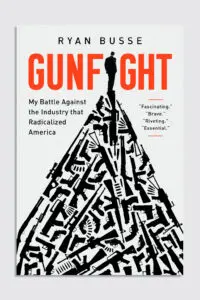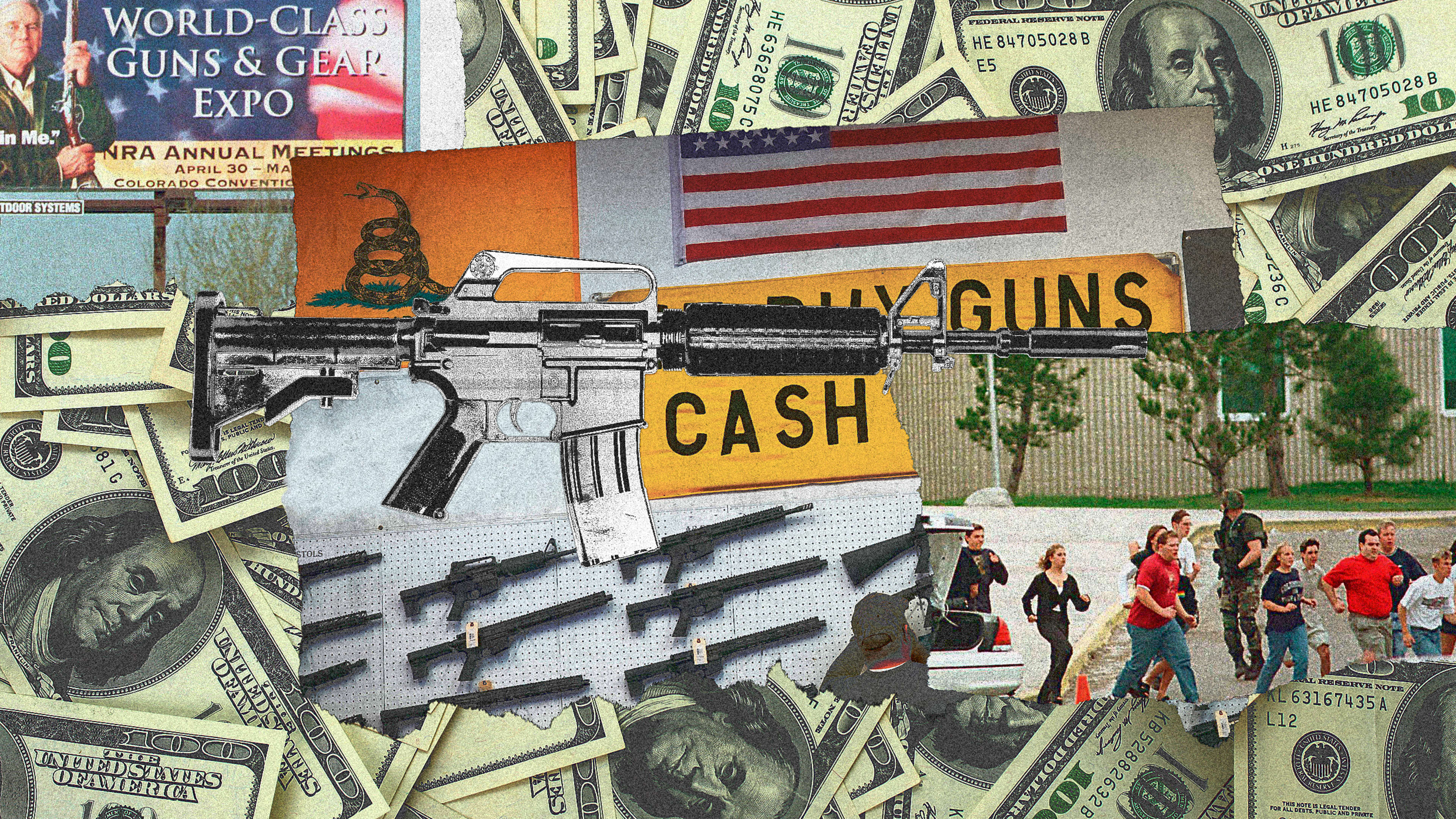Ryan Busse is a former firearms executive who spent 25 years at Kimber America, a high-end gun manufacturer, rising to become VP of sales. Over the years, he became disillusioned with an increasingly extremist gun industry, and began speaking out against the National Rifle Association. He resigned in 2020 to advocate for gun violence prevention, becoming an adviser to Joe Biden’s presidential campaign. He is now senior adviser to gun-safety group Giffords. His book, Gunfight, exposes the radicalization of the industry from a first-person perspective. Below is an excerpt of the book, which is out in paperback this week.
On the morning of April 20, 1999, I held a staff meeting in my office. “It’s going to be a big show this year,” I said, eyeing some of my newer employees, who had never attended an NRA convention. The annual convention was set to begin in about 10 days in Denver, and we were getting ready to showcase more than 100 new Kimber pistols and about 40 rifles.
The NRA show, and all the scheduling around it, was an enormous undertaking. Just as I began to discuss the logistics for our hotel rooms and airline reservations, our office secretary stuck her head in the meeting. “You guys need to watch the news,” she said before a big swallow. “There is some shit going down in Denver.”
I fumbled with a radio and then clicked through slow and clunky news websites to see what was happening in the Denver suburb of Columbine.
The early reports of the shooting at Columbine High School indicated that two students had used a variety of guns and explosives to kill 13 and wound 24 more. My usually loud and gregarious sales staff sat quiet and motionless as we waited for each new bit of information.
Photos that slowly flashed across my screen began to answer our questions. We saw screaming kids, distraught parents, and teachers comforting students. People raced across the parking lot to escape the carnage. For those of us in the sales office, a single question on all our minds remained unanswered: What guns did they use? One of the sales guys let it slip: “Was it a Kimber?”
Not long after the entire nation began learning about the massacre in Columbine, my phone rang. “You watching this?” [My wife] Sara said, her voice trembling. “Those poor kids! The gun industry is okay with this shit?” I must have stammered for a few awkward moments before she added, “Are you okay with this, Ryan?”
“No, I am not okay with it,” I whispered into my phone, careful not to let anyone in the office know how upset Sara was. “Look, I’m pretty sure that they did not use any Kimbers.”
“That’s what you have to say for yourself?” she retorted. “That they didn’t use your guns?”
Everyone in the building wanted to believe that we were immune to the guilt that would follow if the world learned that Eric Harris and Dylan Klebold used Kimbers as they murdered their teachers and classmates. Somehow, it still seemed reasonable to all of us to believe that the terror in Colorado was beneath Kimber. After all, we had not been making handguns that long. And they were expensive, classic, and not high capacity. Of course, we also knew that nothing was certain. Deep down, everyone understood there would always be the possibility that our product could end up in a scene like Columbine.
As we processed the horror and pondered that possibility, my screen flashed with the disturbing scene of a bloodied boy dangling out of a high window in the school. Three shots from the killers had struck 17-year-old Patrick Ireland, two of them in the head. Despite profuse bleeding, he somehow managed to crawl across the floor to the broken window, then lobbed himself over the edge of the opening.
A primal fear of dying and a more primal instinct of flight pushed Patrick to escape the rampage inside. Two SWAT officers caught his fall from the window, and despite his terrible injuries, he survived.
For a nation dealing with its first high-profile mass shooting in a school, Patrick’s dramatic escape came to represent an almost unspeakable fear. It was and still is horrific to watch. But like those at the other gun companies, we were conditioned to convert news of events like the Columbine massacre into calculations about how they would affect our work selling guns.
Within a couple of hours, the staff slowly trickled back to their offices and began returning calls and speaking to dealers. It was easier than it should have been to just go back to work. We claimed to be above it all, and that was my doing.
It began with [Kimber co-founder] Greg Warne’s admonition from years earlier: “We don’t want Kimber to be a company that makes guns found in crime scenes.” Greg and I both knew that there was an unspoken line of bifurcation in the gun business. We all knew that higher-quality, more-expensive, lower-capacity guns were far less likely to be used in crimes. Lower-quality, less-expensive, high-capacity “assault”-style guns were far more likely.
The industry wrestled with this reality too, but it also understood the basic laws of economics. In order for a company to grow, it needed new business. Less-expensive products would appeal to a higher number of customers. Edgy or “dangerous” products also had an upside because they could garner press attention, or maybe they’d have a chance at selling at higher numbers. The trick, as I saw it, was to try to find just the right balance. I’d build a growing company that focused on high-quality products. And this meant that I’d have to find a way to buck the basic laws of economics. To pull it off, we’d need a trained eye for style and more than a little bit of luck.
I managed to stay successful in demanding the quality side of our product line. “Don’t worry. You don’t have to be embarrassed about selling a Kimber,” I’d say while recruiting salespeople. “Ours are not guns that will end up in BATF criminal traces. . . . We don’t make that kind of stuff and never will as long as I’m here.” That was a promise I made to my staff. I made a promise to myself to keep it.
Of course, it wasn’t long before the events in Denver affected us too. It started late in the day when dealers, especially stores around the Denver area, began calling to adjust their orders. In only a few hours, Columbine had produced a sick business-success story for the entire industry.
“These dealers think there might be a sales spike,” one of my salesmen told me after I stuck my head into his office. Dealers were parroting three years of NRA talking points: “The Democrats are going to use this to jam more gun-control shit down our throats. So they’re doubling and tripling their orders!”
This quick and fearful reaction was a relatively new development. The passage of the Brady Bill and the assault weapons ban had simmered over time. To gain maximum advantage, the NRA realized it needed to keep the ingredients ready, to keep stirring the pot. So it set out to supercharge the nation’s political landscape.
For that to happen, the NRA needed constant heat. In fact, it had started priming the reaction to the Columbine massacre three years earlier at its 1996 national convention, an event conspicuously held on the first anniversary of the Oklahoma City bombing. When industry members like us asked about holding the convention on this solemn anniversary, we were told that consideration had been given to changing it but that no one in the NRA wanted to show any sign of weakness. I attended that 1996 convention in Dallas. It was a presidential election year, and I could feel the fear pulsing through the attendees as they stumbled out of dim ballrooms following speeches meant to drive down reason and to drive up sales.
In her speech at the Dallas NRA convention in 1996, NRA president Marion Hammer seemed to tap into a new, long-lasting source of fear and hatred that could keep the pressure cooker of a divided America just one tick below maximum. Apparently, she also knew it was important to divert attention from reality. For that, she needed boogeymen who looked different from the NRA members, and the Clinton administration’s much-touted outreach to troubled inner-city youths in the 1994 crime bill provided the perfect target. “Too many [youngsters] have no wholesome recreational activities and as a result, they’ve been left hanging,” she said with a voice deepened by years of cigarette smoke. “Hanging out in the malls, hanging around crack houses, and hanging out in limbo without a moral compass . . . is wrong and it has to be fixed, and midnight basketball is not the answer.”
Hammer’s racist dog whistle echoed through the halls of the NRA for the next 25 years. And it was a frontal attack on President Clinton’s plan aimed at helping inner-city kids in the most disenfranchised parts of our country.

After Hammer unscrewed the lid on the racial undertones, a speech by the NRA’s chief lobbyist poured the contents on the floor, drawing a line in the sand between “them” and “us.” As the organization’s official statements proclaimed in Dallas: “The Second Amendment is facing the greatest political challenge of this century. Our opponents—the antiprison movement, the anti-hunting movement, the anti-self-defense movement—are pouring tens of millions of dollars into this election year. Right now, Bill Clinton has pulled out all the stops to separate your Second Amendment from the rest of your Bill of Rights.”
Excerpted from Gunfight: My Battle Against the Industry That Radicalized America by Ryan Busse. Copyright 2023. Available from PublicAffairs, an imprint of Hachette Book Group.
Recognize your brand’s excellence by applying to this year’s Brands That Matter Awards before the early-rate deadline, May 3.
